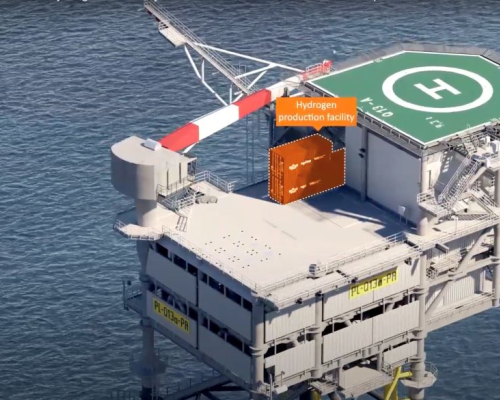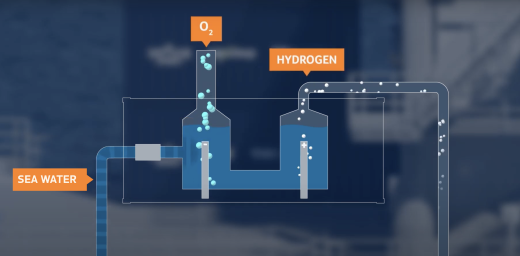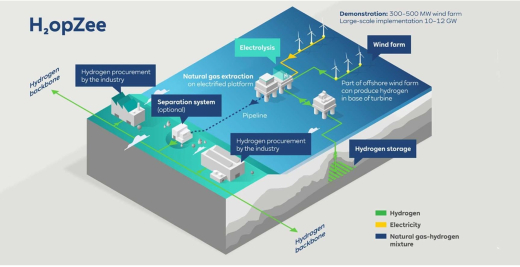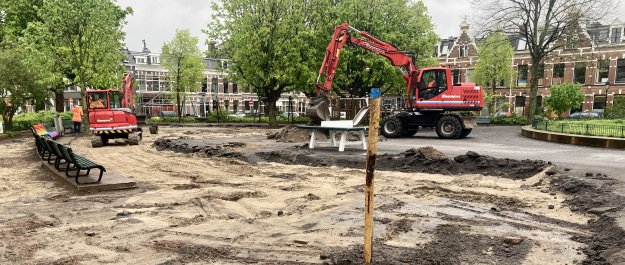As the Netherlands makes its way towards net-neutrality in 2050, it’s exploring a variety of scenarios and technologies that can bring that goal in sight. The country’s small size and high population density has directed a significant amount of focus toward building large scale wind parks in the North Sea, off the Dutch coast. Various initiatives are exploring solutions for buffering the fluctuations that characterise wind power, which prevent optimal and consistent production.
Green hydrogen takes to the sea
Green hydrogen is among the most promising technologies for that purpose. Off the Scheveningen coast, a particularly proactive consortium of 13 partners, initiated by Neptune Energy, NEXSTEP and TNO, is piloting offshore hydrogen production through the project PosHydon on the fully electrified gas production platform Q13-a. The benefits of offshore hydrogen production promise to be manifold, in particular when used as a complementary buffer for wind parks beyond 100km offshore.
The Netherlands powers up at sea
By the end of 2023, 4,5GW will be generated by wind parks off the Dutch coast, which is to be amplified to an astonishing 50GW by 2040. And as the wind parks grow, so does the distance to the shore and the number of users of the area, making the transportation of energy through the delicate aquatic ecosystems an increasingly complex puzzle. Contrary to what your intuition may tell you, at distances exceeding 100km, more energy is lost in transportation through electric cables than through gas pipes. This is where offshore hydrogen production can take center stage. And because the Netherlands has historically relied heavily on its domestic gas supply, the country has an advanced gas pipeline network in place, both off and onshore.
Hydrogen can supplement natural gas through those existing offshore pipe networks, making the construction of new cables superfluour and new pipeline infrastructure limited. Another advantage is that the emptied gas fields that are located just there at the platforms, can be used to store green hydrogen, to be transported to users on demand.
“Like all energy solutions, there is controversy about the feasibility hydrogen. But we believe that the potential benefits of hydrogen are so convincing that it is worth a try. Furthermore, there is only one way to find out: by getting started.”
The PosHYdon project is an excellent example of how the Dutch innovate by doing, involving industry, government and research partners and establishing an open innovation infrastructure. On the Q13a-A platform, a 1MW H2 production container will be installed, with green energy supply that mimics input generated by a nearby wind park, called Luchterduinen, of PosHYdon partner Eneco. At the platform, sea water is demineralised and converted by an electrolyser of NEL Hydrogen into hydrogen and oxygen.
Among various concepts being validated within this project is supplementing H2 through existing gas pipes. To see that validation process through, the owner of the Dutch gas transport network Gasunie, a government-owned organisation, is an active partner in the project. The project is also used to discover regulatory bottlenecks in legislation that need to be resolved as well as how to preserve the value of the hydrogen, e.g. through certificates of origin, and to learn more about the economics of offshore H2 production.
In parallel with the PosHYdon project, several other demonstration projects are developed, one of them being a larger project aiming for up to 500MW H2 production on the North Sea. This project, named H2opZee, builds on lessons learned in PosHYdon and involves different validation topics. Initiated by government-supported TKI Wind op Zee, Neptune Energy and RWE are in the lead.
“The complexity of getting offshore hH2 production operational at large scale requires a wide set of partners with an equally diverse range of expertise and influence."
René continues: "Because the Dutch are very experienced with collaborating on complex offshore projects across government, research institutions and industry, this project has a very real chance of succeeding within a reasonable time frame, given the Dutch green energy ambitions as stated in Esbjerg.”
The Hague
The Q13a-A platform, which is the stage for the PosHYdon project, is located at 13km off the Scheveningen coast. The area has been appointed a testing ground for offshore innovation. Within eye sight from the Q13a-A platform, lies the offshore test site Campus@Sea, where a multitude of partners are exploring multi-use concepts within wind-parks. Here, industrial scale seaweed farming, floating solar power and mussel and oyster farming is being developed. “The Hague, which is the only large city in the Netherlands with direct access to the North Sea, is committed to growing its blue economy in an eco-positive way," says Philip Mulder, account manager energy for The Hague Business Agency.
"Because of the roughness of the North Sea, professionals often joke that if it can be done here, it can be done everywhere. In other words, the concepts that are developed here can make a positive impact on many places across the globe and contribute to a better world for all.”
Get in touch!
Get in touch for more information about PosHYdon and the energy sector in The Hague, and for warm introductions to the thought leaders, experts and entrepreneurs in the local energy community.





